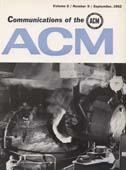September 1962 - Vol. 5 No. 9

Features
Programmed methods for printer graphical output
It is frequently desirable to display the results of computation in a graphical form. This is often done through the use of special hardware such as digital X,Y-plotters. Programmed graphical output for standard printers is preferable in several situations: (1) when economic considerations do not justify the expense of special hardware for the purpose, (2) when a combination of graphical output with some other kind, such as explanatory material, is desired, and (3) when some special variety of graphical output is needed which cannot readily be drawn by an analog device.
A number of routines have been prepared (primarily by users rather than manufacturers) to convert numerical data into graphical form for printing by output typewriters or line printers. Virtually nothing on this subject has been published, and this report represents an admittedly incomplete attempt to describe this technique and suggest possibilities for its use.
Current status of IPL-V for the Philco 2000 computer (June 1962)
The initial version of IPL-V for the Philco 2000 has been completed and is now operating on the computer. This model, IPLT-1, contains the loader, interpreter, output, housekeeping functions, and some of the primitives of the 7090 version.
This system was written mainly in JOVIAL, a procedure-oriented language, and was compiled to produce a Philco TAC binary operating deck. Certain portions were written in Philco TAC language to speed up the operation of the system during execution and to facilitate handling of primitives which in JOVIAL would have been uneconomical. These assembly-language coded sections constitute less than 3 percent of the system.
The present model assembles IPL program cards at the rate of 500 per minute in the listing mode. This compares favorably with the 7090 model, since System Development Corporation's configuration of the Philco computer operates at approximately one-fifth the speed of the 7090. Interpretation time also compares favorably with the 7090 model taking into account the difference in speeds of the two computers. The package of J primitives produced by H. A. Simon is being used and assembled with the IPL program. With listing suppressed, assembly time of these routines is only a few seconds. Input to the Philco 2000 is by card, and the system operates as a program executed in phase three of the SL Philco operating system. The J165, J166 dump and reload features are working, and this technique can be used to save an assembled IPL program on tape for later use. Unused region assignments are not returned to available space; therefore additional routines may be added with new data for reload and run from a dump tape. However, card input is extremely fast (2000 cards per minute) and normal operating procedure at SDC is card input.
A heuristic for page turning in a multiprogrammed computer
One school of thought for future computer systems involves the use of large computer complexes, time-shared among many users. Because internal computer speeds are so much greater than communication speeds with the outside world, machine efficiency requires that a large system be capable of working on many programs at once, and working on each in turn while others are completing input-output operations. One approach [1] to a successful multi-programmed computer has been called “page turning”, where the object programs are automatically broken into blocks of a fixed size (pages) and these pages are then shuffled in and out of the main store automatically by the operator system as reference to the data or instructions contained in each page may dictate. Experience to date indicates that this process is prohibitively time-consuming if significant hardware features are not included to aid the executive program in carrying out this task. It is not the purpose of this note to discuss these hardware features but to address specifically a single aspect of the situation which remains a problem even if adequate hardware features are provided.
On the nonexistence of a phrase structure grammar for ALGOL 60
ALGOL 60 is defined partly by formal mechanisms of phrase structure grammar, partly by informally stated restrictions. It is shown that no formal mechanisms of the type used are sufficient to define ALGOL 60.
TALL—a list processor for the Philco 2000 computer
Several of the computer languages that are oriented toward problems in symbol manipulation use a list type of memory organization.1 The advantages of such a memory organization have been discussed elsewhere and will not be repeated here. The purpose of this note is to describe the method used in realizing a list language on the Philco 2000.
Information Processing Language V (IPL-V) was chosen as the source language for the list processor for the 2000 because this language has been well documented and has been implemented on several computers.2 Heretofore, IPL-V has been implemented as an interpretive system. The interpretive system has three major components: (1) a loader which translates card images into internal machine words; (2) an interpreter which decodes instructions; and (3) a set of primitive processes, the “J's,” which make up the bulk of the instruction vocabulary. The implementation of such an interpretive system has been a rather lengthy procedure usually estimated as taking six man-months.



